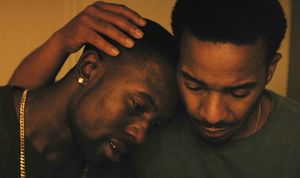Difference between revisions of "Lighting for Video"
(Created page with " == Introduction == Everything we do with cameras and lenses is about capturing light. A scene may be lit with '''available light'''--using natural or man-made light that is...") |
(Tag: VisualEditor) |
||
| Line 4: | Line 4: | ||
== Light == | == Light == | ||
| + | [[File:Media Lighting Moonlight Still.jpg|alt=Still from Moonlight, Barry Jenkins, 2016|none|thumb|Still from Moonlight, Barry Jenkins, 2016]] | ||
| + | |||
To start to understand light, look at a painting, photograph, or scene in a movie and ask yourself: | To start to understand light, look at a painting, photograph, or scene in a movie and ask yourself: | ||
* What kind of shadow does it cast (crisp or diffuse)? | * What kind of shadow does it cast (crisp or diffuse)? | ||
Revision as of 13:00, 16 January 2019
Introduction
Everything we do with cameras and lenses is about capturing light. A scene may be lit with available light--using natural or man-made light that is already at the location--or with lighting the the filmmaker controls. The way a scene is lit influences both how we understand the scene and how we experience it emotionally. Light directs the viewer's attention. It provides cues, creates depth, surface texture, or can flatten, compress, and smooth over features. Quality of light has a powerful effect on the mood of a scene.
Light
To start to understand light, look at a painting, photograph, or scene in a movie and ask yourself:
- What kind of shadow does it cast (crisp or diffuse)?
- What angle is it coming from?
- How bright is it (intensity)?
- How bright is it relative to other lights (lighting contrast)?
- What color is it?
When you are ready to shoot ask yourself the same questions.
Qualities of Light
The hardness of light is a way to describe the type of shadow it casts.

